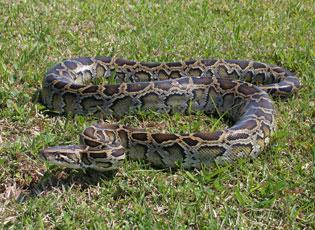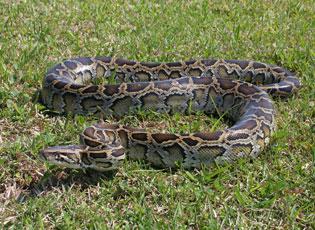Burmese pythons are one of the most notorious invasive species in the world. These massive snakes, native to Southeast Asia, have taken over the Florida Everglades and are causing havoc for the local ecosystem. But are they really as bad as they seem? In this article, we’ll explore the history of the Burmese python in Florida and examine the evidence to determine whether or not they truly deserve their reputation as an invasive species.
From pet trade escapes to intentional releases, Burmese pythons have been making their way into the wilds of Florida for decades. Once there, they quickly established themselves as apex predators, preying on everything from small rodents to alligators. But how much of an impact are they really having on the ecosystem? We’ll take a closer look at the science behind the issue and see if there’s any hope for controlling these formidable snakes.
Yes, the Burmese Python is considered an invasive species in Florida and other parts of the United States. They were originally brought to the area as pets, but many were released or escaped into the wild, where they have thrived and caused harm to native wildlife populations.

Is the Burmese Python an Invasive Species?
Introduction
The Burmese Python, also known as Python bivittatus, is native to Southeast Asia. However, due to the exotic pet trade, some of these snakes were released into the wild in Florida in the 1980s. Since then, the population has grown rapidly and spread to other parts of the United States. This raises the question: Is the Burmese Python an invasive species?
What is an invasive species?
An invasive species is a non-native organism that causes harm to the environment, economy, or human health. Invasive species often have no natural predators in their new environment, which allows them to reproduce and spread unchecked. They can outcompete and displace native species, disrupt ecosystems, and cause economic damage.
How did the Burmese Python become invasive?
The Burmese Python was introduced to Florida through the exotic pet trade. When pet owners could no longer care for their snakes, they released them into the wild. The warm and humid climate of Florida provided the perfect environment for the snakes to thrive and reproduce. As a result, the population exploded and spread to other parts of the United States.
Impacts of the Burmese Python
Ecological Impacts
The Burmese Python is a top predator in its new environment and has no natural predators. This allows it to prey on a wide range of native species, including mammals, birds, and reptiles. The loss of these native species can have cascading effects on the ecosystem, disrupting food webs and altering the balance of nature. In addition, the Burmese Python can spread diseases to native species, further impacting their populations.
Economic Impacts
The Burmese Python has also had significant economic impacts. They have been known to damage infrastructure, such as roads and levees, and cause power outages by climbing power poles. The presence of the snakes has also hurt Florida’s tourism and recreation industries, as people are less likely to visit areas where the snakes are known to be present.
Control and Management
Methods of Control
There are several methods of controlling the Burmese Python population. One method is to physically remove the snakes from the environment. This can be done through trapping and hunting, but it is a difficult and time-consuming process. Another method is to use chemical control, such as spraying areas with a toxic substance that will kill the snakes. However, this method can also harm other species in the environment.
Benefits of Control
Controlling the Burmese Python population is important for protecting the ecosystem and native species. It can also help prevent economic damage and protect human health. By reducing the number of snakes, other species can recover and thrive, and the balance of nature can be restored. Additionally, controlling the population can help prevent the spread of diseases to humans and domestic animals.
Challenges of Control
Despite efforts to control the Burmese Python population, it is still a difficult task. The snakes are elusive and difficult to find, and their ability to reproduce quickly makes it hard to keep up with their numbers. In addition, the snakes can live in a variety of habitats, making it challenging to target specific areas for control.
Conclusion
In conclusion, the Burmese Python is an invasive species that has had significant impacts on the environment, economy, and human health. Controlling the population is essential for protecting native species, preventing economic damage, and maintaining the balance of nature. While controlling the population is challenging, it is necessary for the long-term health of the ecosystem.
Frequently Asked Questions
Here are some frequently asked questions about the Burmese Python as an invasive species:
What is an invasive species?
An invasive species is a non-native species that causes harm to the ecosystem it has been introduced to. These species can outcompete native species for resources and disrupt the balance of the ecosystem.
They can also cause economic and health problems, such as damaging crops and transmitting diseases to humans and animals.
How did the Burmese Python become an invasive species?
The Burmese Python is native to Southeast Asia, but it has become an invasive species in Florida and other parts of the United States. It is believed that the pythons were introduced to the area as a result of the pet trade.
When pet owners could no longer care for their pythons, they released them into the wild. The pythons were able to thrive in the warm, humid climate of Florida and quickly became a problem for native species.
What kind of impact do Burmese Pythons have on the ecosystem?
Burmese Pythons have a significant impact on the ecosystem they have invaded. They prey on native species, such as birds, mammals, and reptiles, which can disrupt the food chain and lead to population declines in those species.
They also compete with native predators for resources, such as food and shelter, which can further destabilize the ecosystem.
What is being done to control the Burmese Python population?
Several measures have been taken to control the Burmese Python population in Florida. These include hunting and trapping programs, as well as public education campaigns to discourage people from releasing pet pythons into the wild.
Researchers are also studying the genetics of the pythons to better understand their behavior and develop more effective control methods.
Can the Burmese Python be eradicated from Florida?
It is unlikely that the Burmese Python will be completely eradicated from Florida, given the large population and the difficulty of finding and removing all of the pythons.
However, efforts to control the population and prevent further spread are ongoing, and researchers are continuing to explore new control methods.
Coastal Invasive Species – Burmese Pythons – FISAW 2020
In conclusion, the Burmese python is undoubtedly an invasive species in certain areas of the United States. Its introduction into the wild has caused significant harm to local ecosystems, leading to the decline of native species and changes in habitat composition. However, it is important to note that not all populations of Burmese pythons are considered invasive, and the species itself is not inherently detrimental to the environment.
Moving forward, it is imperative that action is taken to prevent the spread of invasive Burmese python populations and mitigate their impact on local ecosystems. This may include measures such as increased monitoring and control efforts, as well as public education and outreach initiatives aimed at raising awareness of the issue.
Ultimately, the question of whether the Burmese python is an invasive species is complex and multifaceted. While there is no easy solution to this problem, it is clear that concerted efforts must be made to address the issue and protect our natural resources for future generations.


